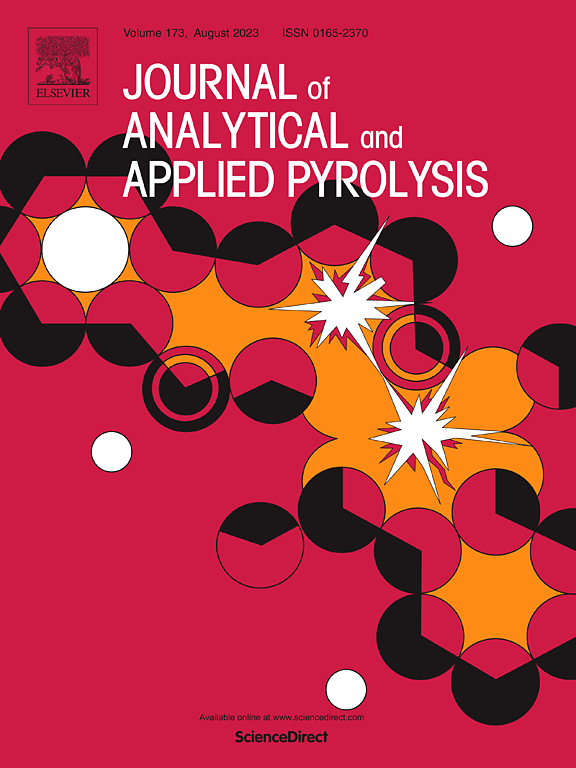Unveiling the potential of thermo catalytic fast pyrolysis for the production of higher quantities of bio-oil: Lignin-derived oxygenates
IF 5.8
2区 化学
Q1 CHEMISTRY, ANALYTICAL
引用次数: 0
Abstract
Optimally loaded SrO (10 %) by weight on H-ZSM-5 for catalytic fixed bed downstream fast pyrolysis of lignin is further investigated. The effect of reaction temperature ranging from 450°C to 750°C on lignin was examined and optimized at 550°C with a nitrogen gas flow of 0.5 liters per minute. Purified lignin to catalyst ratio as 25:5 (wt/wt) afforded a maximum 34.2 wt% bio-oil yield. It is compared with the bio-oil obtained without a catalyst based on percentage yield, product distribution, and quality. The metal oxide showed significant changes in the acidic properties of H-ZSM-5. All original characteristics, respectively, pore volume 0.0836 cm3g−1, surface area 253.039 m2g−1, and pore radius 1.62501 nm of H-ZSM-5 showed a decrease on further increase in metal beyond 10 %. The reaction temperature of pyrolysis over 550°C reduces the yield of bio-oil. ESI-MS of bio-oil obtained using a catalyst indicates an overall shift towards the low molecular weight compounds, decreased PDI, and relatively lesser oligomers studied up to 320 m/z ratio. Base sites of SrO promote the transformation of carboxylic acids into ketones, supporting the loss of oxygen. The role of the acidic site of H-ZSM-5 and base sites of SrO contribute to converting oxygenated compounds to phenols, including esters, acids, alcohols, and phenols hydrocarbons. Typically, hydroxy-acids, hydroxy-esters, etc, showed marked resistance to chemical transformation. In comparison, analysis of pyrolysis gas under optimized conditions shows a 2 % higher hydrogen content by volume. Although under slightly altered conditions, catalyst reuse is demonstrated with a fair response.
揭示热催化快速热解生产更多生物油的潜力:木质素衍生含氧化合物
进一步研究了H-ZSM-5催化固定床下木质素快速热解的最佳负载SrO(10 %)。考察了450 ~ 750℃反应温度对木质素的影响,并在550℃、氮气流量0.5 l / min条件下进行了优化。纯化木质素与催化剂的比例为25:5 (wt/wt),最大生物油得率为34.2 wt%。在产率、产品分布和质量方面,将其与不加催化剂的生物油进行了比较。金属氧化物对H-ZSM-5的酸性有明显的影响。H-ZSM-5的孔隙体积为0.0836 cm3g−1,比表面积为253.039 m2g−1,孔半径为1.62501 nm,随着金属含量的增加超过10% %,其原始特征均呈下降趋势。热解反应温度超过550℃会降低生物油的收率。使用催化剂获得的生物油的ESI-MS表明,总体上向低分子量化合物转变,PDI降低,低聚物相对较少,研究达到320 m/z比。SrO的碱基促进羧酸转化为酮,支持氧的损失。H-ZSM-5的酸性位点和SrO的碱基位点的作用有助于将含氧化合物转化为酚类,包括酯类、酸类、醇类和酚类碳氢化合物。羟基酸、羟基酯等具有明显的抗化学转化能力。相比之下,优化条件下的热解气体体积氢含量提高了2 %。虽然在稍微改变的条件下,催化剂的重复使用表现出良好的反应。
本文章由计算机程序翻译,如有差异,请以英文原文为准。
求助全文
约1分钟内获得全文
求助全文
来源期刊
CiteScore
9.10
自引率
11.70%
发文量
340
审稿时长
44 days
期刊介绍:
The Journal of Analytical and Applied Pyrolysis (JAAP) is devoted to the publication of papers dealing with innovative applications of pyrolysis processes, the characterization of products related to pyrolysis reactions, and investigations of reaction mechanism. To be considered by JAAP, a manuscript should present significant progress in these topics. The novelty must be satisfactorily argued in the cover letter. A manuscript with a cover letter to the editor not addressing the novelty is likely to be rejected without review.

 求助内容:
求助内容: 应助结果提醒方式:
应助结果提醒方式:


